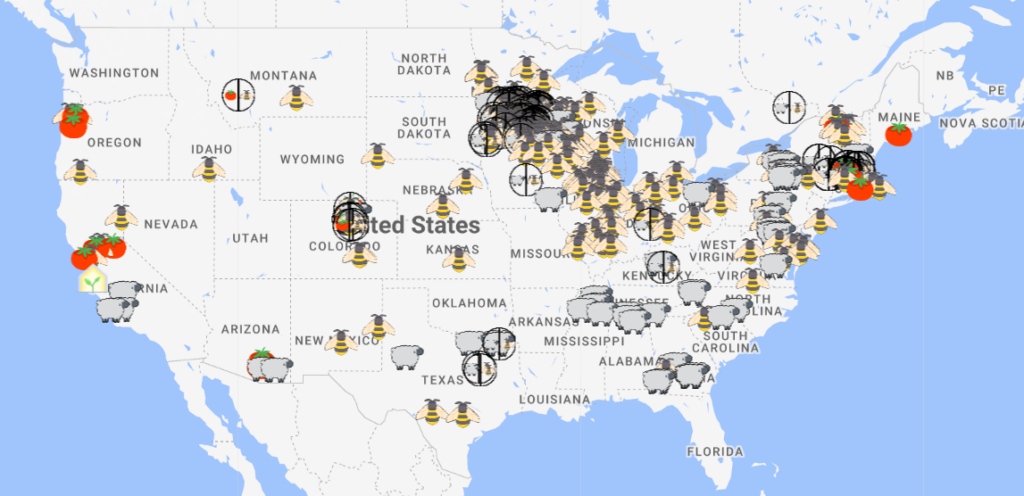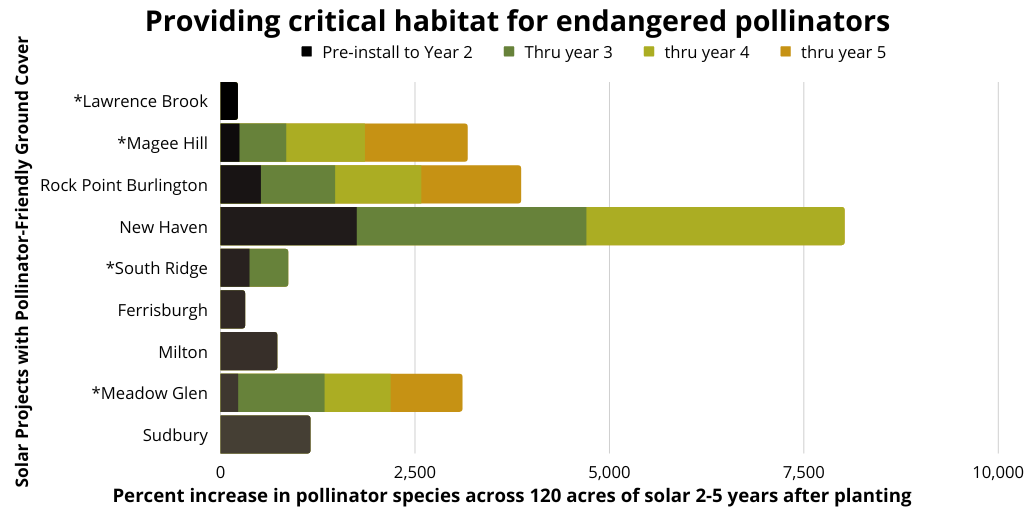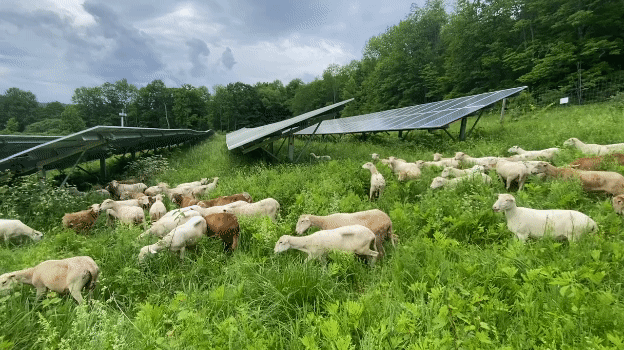Maximizing ecosystem benefits with solar
What is agrivoltaics?
According to the USDA, “Agrivoltaics is the use of land for both agriculture and solar photovoltaic energy generation. It’s also sometimes referred to as agrisolar, dual use solar, low impact solar…This system looks at agriculture and solar energy production as compliments to the other instead of as competitors.”
Agrivoltaics is the co-location of productive and ecologically beneficial land use with the siting of solar energy: in essence, agriculture + photovoltaics. The concept of agrivoltaics was first introduced in the 1980s, and has gained significant traction in the industry in recent years. In practice, agrivoltaics can take many forms, including the creation of pollinator habitat, solar grazing, or even crop production, where crops are grown within the footprint of the solar project. Making the most of solar sites using agrivoltaics creates resilient income for American farmers and restores ecological wealth. There are currently hundreds of agrivoltaic projects in the United States, some of which can be found on inSPIRE’s Agrivoltaics Map.

Planning for an agrivoltaics future
Solar energy is one of the the most cost effective ways to to make the clean energy transition.. In order to meet a goal of 100% renewable energy by 2035, including the Biden Administration goal of having 40% of our nation’s electricity coming from solar by that same date, it is estimated that farmers and other landowners will lease more than 2 million acres of land in the U.S. for community and utility scale photovoltaic solar projects by 2030. As the footprint of solar facilities expands nationwide, there is a pressing need to understand how individual project sites can exist in conjunction with the agricultural economy and the benefits of agrivoltaics.
Agrivoltaics has emerged as a way to increase the availability of suitable sites and allow multi-generational farmers to keep their land and adapt to changing economics. While there are unique considerations developers have to make depending on what form of agriculture will occur under or around panels, we are confident in tackling the complexities of developing sustainable, productive agrivoltaic systems.
Encore: An agrivoltaics leader
We’ve been at the forefront of agrivoltaics in our region, successfully developing Vermont’s first large scale pollinator-friendly solar project in Hinesburg in 2017. In 2020, we made a commitment that every future Encore project would feature dual-use of some kind, whether habitat for pollinators, solar grazing, or other agrivoltaic solutions on the cutting edge. We have a long term partnership with Bee the Change, a Vermont-based farm specializing in the creation of pollinator habitat on solar sites. We also partner with Agrivoltaic Solutions to utilize sheep grazers, supporting the next generation of small farms.
We’re passionate about designing solar projects with the maximum benefits for surrounding ecosystems and the local communities. Guided by core values of innovation, curiosity, and integrity, we’re excited to explore emerging techniques for dual-use solar projects.
NREL research has found that agrivoltaic systems can increase land productivity, decrease water use and benefit solar energy output
Advantages of agrivoltaic systems
Farming is historically a business with thin margins, and it’s hard for intergenerational farmers to continue their family’s work. As the climate changes and risks to crop and farmland become more threatening, those margins become even slimmer. By diversifying income and helping to mitigate climate change at the same time, dual use solar adds resiliency to America’s farming economy. Agrivoltaics also creates greater opportunities for protecting biodiversity and restoring ecosystems.
When responsibly planned and managed, agrivoltaics can leave the land around a solar project much better than before. Pollinator-friendly and non-invasive plantings can restore nutrients and sequester carbon in the soil, and grazing creates natural fertilizer and invasive species management. With increased habitat and thoughtful planting, endangered pollinator species can thrive, as shown by the chart from Bee the Change below.

On average we saw a 612% increase in pollinator species during the first 2 years and 1174% increase for solar projects with pollinator friendly ground cover in 5 years.
The future of agrivoltaics policy
As research continues to show the many ways that agrivoltaics can benefit solar, farmers, and the environment, policy makers have joined the conversation. In 2023, there were multiple bi-partisan efforts to support solar development and agriculture. The Agrivoltaics Research and Demonstration Act of 2023 and the Protecting Future Farmland Act demonstrate a growing awareness of the critical role that agrivoltaics will play in our future. In order for a policy to effectively expand the development and deployment of solar and agriculture it must at a minimum mitigate any potential cost differential from a business as usual approach (both for farming and for solar), but ideally will increase revenue potential. It’s also important to expand opportunities to support the ongoing research into innovations in this emerging segment of the market.
Agrivoltaic policy drivers
1. Make requirements flexible to allow Farmers to dictate agricultural requirements for the farm and allow solar to be designed to meet those needs.
Each farm has unique factors to consider based on crops, growing seasons, geography, available land and federal agricultural regulations. There is no reason to include overly restrictive parameters like module height or rack spacing as a requirement for agrivoltaic deployment.
2. Streamline agricultural tax incentives to allow for dual land use.
If farmers can demonstrate that land meets federal agricultural tax requirements, it should continue to receive preferential tax treatment.
3. Create funding opportunities to explore innovative agrivoltaic solutions.
There are a few opportunities at the federal level, as well as, across several states to authorize grants and additional incentives for new or ongoing demonstration or research projects that demonstrate or study the use of agrivoltaics.
4. Educate the agricultural community on the opportunity and benefits of co-locating solar on the farm.
Provide state agricultural agencies with the resources to educate farmers on how to benefit from dual land-use opportunities.









 The team at Encore Renewable Energy® is proud to be certified as a B Corp, joining over 3,500 other businesses worldwide who also share a commitment to social and environmental performance, accountability and transparency.
The team at Encore Renewable Energy® is proud to be certified as a B Corp, joining over 3,500 other businesses worldwide who also share a commitment to social and environmental performance, accountability and transparency.